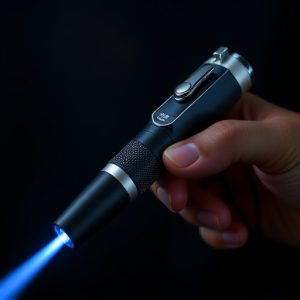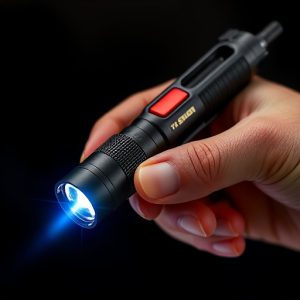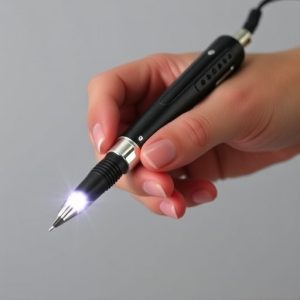Taser vs Stun Gun: Understanding Key Differences & Benefits of Pen Stun Guns
Tasers (Conductivity Energy Devices) and pen stun guns are electroshock weapons for self-defense, di…….
Tasers (Conductivity Energy Devices) and pen stun guns are electroshock weapons for self-defense, differing in design, range, and force. Tasers, used by law enforcement, employ two probes to disable targets up to 21 feet away with high voltage, while pen stun guns, compact and handheld, emit focused charges within arm's length for localized protection. Choosing between them depends on individual needs and local regulations regarding voltage and use.
In today’s world, understanding personal defense options is crucial. Among popular choices, Tasers and pen stun guns stand out as powerful tools. This article delves into the intricacies of these devices, offering a comprehensive guide for consumers. We begin by ‘Understanding Tasers’: their unique design and functionality that sets them apart from traditional stun guns. Subsequently, we explore ‘Pen Stun Guns’ – compact yet formidable powerhouses designed for convenience and ease of use. By comparing key differences, readers can make informed decisions regarding self-defense options, focusing on the distinct advantages of each.
- Understanding Tasers: Design and Functionality
- Exploring Pen Stun Guns: Compact Powerhouses
- Comparison: Key Differences Between Tasers and Pen Stun Guns
Understanding Tasers: Design and Functionality
Tasers, officially known as Conductivity Energy Devices (CEDs), are electroshock weapons designed to temporarily incapacitate a person through the use of an electrical current. They fire two small probes connected to wires that deliver a powerful electric pulse to disrupt muscle control, causing the target to experience intense pain and temporary paralysis. This disruption is achieved by interrupting the body’s nervous system signals, specifically those responsible for controlling muscles.
Unlike traditional stun guns that rely on high-voltage, low-current electrical charges to stun a target, Tasers use lower voltage but higher current, making them more effective at penetrating clothing and reaching deeper muscle tissues. The design of a Taser typically includes a grip with triggers to fire the probes, along with a power source and control circuits. Some modern models also incorporate features like laser sights for precision targeting and different settings for varying levels of force, making them distinct from pen stun guns, which are often smaller, manual devices designed for personal protection, using high-voltage electrical pulses in a more localized area.
Exploring Pen Stun Guns: Compact Powerhouses
Pen stun guns, also known as personal stun devices or electric shock pens, are compact and discreet self-defense tools designed to provide users with a powerful yet portable option. These innovative gadgets pack a surprising amount of punch in their small frames, typically delivering a strong electrical current that can temporarily disable an attacker.
Unlike traditional stun guns that often resemble firearms, pen stun guns are ergonomically designed to fit comfortably in the palm of your hand. Their compact size makes them easy to carry and conceal, allowing users to be prepared for unexpected situations without drawing unnecessary attention. With a simple click or activation mechanism, these devices emit a powerful electric shock, rendering an assailant immobilized for a crucial moment, giving the user time to escape or seek help.
Comparison: Key Differences Between Tasers and Pen Stun Guns
When comparing tasers to pen stun guns, several key differences emerge. Tasers are designed for law enforcement and military use, featuring two probes that deliver an electrical current to disrupt muscle control, causing temporary incapacitation. In contrast, pen stun guns, as their name suggests, resemble a pen and offer a more compact solution for personal protection. They emit a focused electric charge aimed at neutralizing the target without the need for physical contact.
While tasers have a longer range—typically up to 21 feet (6.4 meters)—pen stun guns are designed for close-quarters defense, delivering their shock within arm’s length. Pen stun guns also generally have lower voltage settings, making them safer for use by non-professionals. However, they may not provide the same level of force as tasers, which is why understanding your specific needs and local laws is crucial before choosing between these two electrical self-defense devices.
In exploring the options for personal defense, understanding the distinctions between a Taser and a pen stun gun is key. While both offer non-lethal force as a last resort, their unique designs and applications set them apart. Tasers, with their electrical current delivery system, provide a powerful incapacitant over a longer range. Pen stun guns, on the other hand, offer compact, easy-to-carry power in a small form factor, making them ideal for close-quarters defense. When considering self-defense options, understanding these differences can help individuals make an informed choice based on their specific needs and circumstances. For those seeking a more portable option, pen stun guns excel; but for situations demanding greater reach and impact, Tasers prove more suitable.


